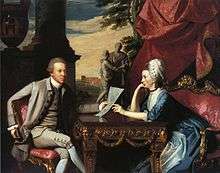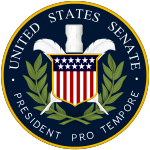Ralph Izard
| Ralph Izard | |
|---|---|
 Ralph Izard 1793, by John Trumbull, American, 1756–1843 | |
| 4th President pro tempore of the United States Senate | |
|
In office May 31, 1794 – November 9, 1794 | |
| President | George Washington |
| Preceded by | John Langdon |
| Succeeded by | Henry Tazewell |
| United States Senator from South Carolina | |
|
In office March 4, 1789 – March 4, 1795 | |
| Preceded by | Position established |
| Succeeded by | Jacob Read |
| Delegate from South Carolina to the Congress of the Confederation | |
|
In office November 4, 1782 – November 1, 1783 | |
| Personal details | |
| Born |
January 23, 1741 / 1742 near Charleston, South Carolina |
| Died |
May 30, 1804 (aged 62–63) near Charleston, South Carolina |
| Political party | Pro-Administration |
| Spouse(s) | Alice DeLancey |
| Children |
Ralph Izard George Izard |
| Alma mater | Trinity Hall, Cambridge |
| Profession | Planter |
| Religion | Episcopalian |
| Signature |
|
Ralph Izard (January 23, 1741/1742 – May 30, 1804) was a U.S. politician. He served as President pro tempore of the United States Senate in 1794.
Early life
Izard was born at "The Elms" near Charleston, South Carolina. He was the son of Henry Izard and Margaret Johnson. His great-grandfather was Ralph Izard[1] (1660–1710), who was born in Dorchester, England and settled in South Carolina. His maternal grandfather was Province of South Carolina Governor Robert Johnson. Izard's parents died when he was a small child, and only one of his siblings survived to adulthood. He spent most of his childhood and youth studying in England: he attended a school in Hackney, London, and matriculated as a fellow-commoner at Trinity Hall, Cambridge.[2] Izard returned to America in 1764, but did not remain in South Carolina for long.
Marriage and children
In 1767, Izard married his niece Alice De Lancey, who was a niece of James DeLancey and a descendant of Stephanus Van Cortlandt and Gertrude Schuyler. Izard and his wife had fourteen children together, but only seven survived past early childhood. His most notable children were George Izard and Ralph Izard (naval officer). After Izard moved to America in 1780 to focus on his work towards the American Revolution, his family stayed in France until 1783 when they joined him in South Carolina.[3]
Career
He resided in London in 1771 and moved to Paris, France, in 1776. He was appointed commissioner to the Court of Tuscany by the Continental Congress in 1776, but was recalled in 1779. He returned to America in 1780 and pledged his large estate in South Carolina for the payment of war ships to be used in the American Revolutionary War. He was a member of the Continental Congress in 1782 and 1783. In 1788, he was elected to the United States Senate and served from March 4, 1789, to March 4, 1795, serving as President pro tempore of the Senate during the Third Congress.
Death and legacy
Izard retired from public life to the care of his estates in 1795. Within 2 years of his retirement, he was stricken with an untreatable illness that paralyzed him on one side of his body. On May 30, 1804 near Charleston, Izard died at the age of sixty-two. He is interred in the churchyard of St. James Goose Creek Episcopal Church, near Charleston.
Izard was one of the founders of the College of Charleston. His legacy was carried on by his children and other relatives:
- His son Ralph, was a naval hero of Tripoli. The World War II USS Izard was named after him. (Ralph's wife was a niece of Arthur Middleton.)
- A son, Major General George Izard, was a Governor of Arkansas.
- A daughter, Anne, married William Allan Deas {1764-1863} with whom they had a son, the painter, Charles Deas. William's brother was Col James Sutherland Deas {1784-1864} who was the father of CS General Zachariah Cantey Deas
- A daughter Charlotte married William Loughton Smith {a son of S.C. Assemblyman Benjamin Smith}; William L. Smith was also a brother-in-law of South Carolina Congressman Isaac Motte.
- A cousin Sarah Izard married South Carolina Loyalist Governor Lord William Campbell.
- One niece was a daughter-in-law of Loyalist Governor of Georgia James Wright (governor).
- Another niece was a daughter-in-law of Congressman of South Carolina Thomas Pinckney.
- A great-grandson of Ralph Izard was Charles Manigault Morris who was also a great-grandson of Lewis Morris. A cousin of Charles Manigault Morris was General Arthur Middleton Manigault who was descended from Mary Izard-cousin of Ralph Izard
 Ralph and Alice Izard by John Singleton Copley
Ralph and Alice Izard by John Singleton Copley_-_Google_Art_Project.jpg) Miniature of Elizabeth (Eliza) Izard (Mrs. Thomas Pinckney, Jr.) by Edward Greene Malbone
Miniature of Elizabeth (Eliza) Izard (Mrs. Thomas Pinckney, Jr.) by Edward Greene Malbone
References
- ↑ http://www.familysearch.org/eng/default.asp
- ↑ "Izard, Ralph (ISRT761R)". A Cambridge Alumni Database. University of Cambridge.
- ↑ http://articles.westga.edu:2609/servlet/Sabin?dd=0&locID=carr52158&d1=SABCA04589100&srchtp=a&c=1&an=SABCA04589100&df=f&d2=14&docNum=CY3803265979&h2=1&vrsn=1.0&af=RN&d6=14&d3=14&ste=10&stp=Author&d4=0.5&d5=d6&ae=CY103265966
External links
- United States Congress. "Ralph Izard (id: I000053)". Biographical Directory of the United States Congress.
| United States Senate | ||
|---|---|---|
| Preceded by None |
U.S. Senator (Class 3) from South Carolina 1789–1795 Served alongside: Pierce Butler |
Succeeded by Jacob Read |
| Political offices | ||
| Preceded by John Langdon |
President pro tempore of the United States Senate May 31, 1794 – November 9, 1794 |
Succeeded by Henry Tazewell |

